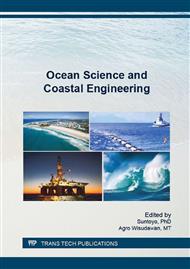p.41
p.46
p.55
p.61
p.67
p.72
p.78
p.83
p.90
Seasonally Variation of Significant Wave Height for 25 Year Period Based on JMA/MRI-AGCM3.2 Wind Climate Data
Abstract:
The global ocean wave climate has long been of interest to the ocean engineering community because of the need for accurate operational wave data for applications such as vessel design, design of offshore and coastal structures or naval operations. Recently, there has been a major interest in wave climate changes as a result of global warming. Therefore, studies on predicting the effect of global warming on ocean wave climate are required. The objectives of this study are to analyze the accuracy and variability of global significant wave height hindcast for the 25 year period 1979-2003. This study describes the 25 year global significant wave height simulation derived from the Japan Meteorology Agency/Meteorology Research Institute (JMA/MRI)-AGCM3.2 wind climate data. The wind climate data were input into ocean wave model WAM with a global grid of spacing 1o in latitude by 1o in longitude. In situ wind and wave data sets from National Data Buoy Center (NDBC)-National Oceanic and Atmospheric Administration (NOAA) database were used to evaluate the hindcast accuracy. The validation showed good agreement both wind and waves data. The wave hindcast analysis show that the seasonal variability of significant wave height in the Northern Hemisphere is greater than in the Southern Hemisphere. Meanwhile, most of the equatorial regions are in calm condition all year.
Info:
Periodical:
Pages:
67-71
Citation:
Online since:
January 2017
Keywords:
Price:
Сopyright:
© 2017 Trans Tech Publications Ltd. All Rights Reserved
Share:
Citation:


